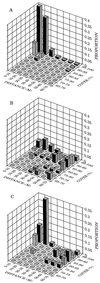Directed seed dispersal by bellbirds in a tropical cloud forest
- PMID: 9600942
- PMCID: PMC27627
- DOI: 10.1073/pnas.95.11.6204
Directed seed dispersal by bellbirds in a tropical cloud forest
Abstract
A fundamental goal of plant population ecology is to understand the consequences for plant fitness of seed dispersal by animals. Theories of seed dispersal and tropical forest regeneration suggest that the advantages of seed dispersal for most plants are escape from seed predation near the parent tree and colonization of vacant sites, the locations of which are unpredictable in space and time. Some plants may gain in fitness as a fortuitous consequence of disperser behavior if certain species of dispersers nonrandomly place seeds in sites predictably favorable for seedling establishment. Such patterns of directed dispersal by vertebrates long have been suggested but never demonstrated for tropical forest trees. Here we report the pattern of seed distribution and 1-year seedling survival generated by five species of birds for a neotropical, shade-tolerant tree. Four of the species dispersed seeds to sites near the parent trees with microhabitat characteristics similar to those at random locations, whereas the fifth species, a bellbird, predictably dispersed seeds under song perches in canopy gaps. The pattern of seedling recruitment was bimodal, with a peak near parent trees and a second peak, corresponding to bellbird song perches, far (>40 m) from parent trees. Seedling survival was higher for seeds dispersed by bellbirds than by the other species, because of a reduction in seedling mortality by fungal pathogens in gaps. Thus, bellbirds play a significant role in seed dispersal by providing directed dispersal to favorable sites and therefore may influence plant recruitment patterns and species diversity in Neotropical forests.
Figures



References
-
- Harper J L. Population Biology of Plants. London: Academic; 1977.
-
- Willson M F. In: Seeds: the Ecology of Regeneration in Plant Communities. Fenner M, editor. Wallingford, U.K.: CAB; 1992. pp. 61–85.
-
- Howe H F, Smallwood J. Annu Rev Ecol Syst. 1982;13:201–228.
-
- Herrera C M, Jordano P, Lopez-Soria L, Amat J A. Ecol Monogr. 1994;64:315–344.
-
- Schupp E W, Fuentes M. Écoscience. 1995;2:267–275.
LinkOut - more resources
Full Text Sources

